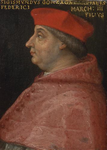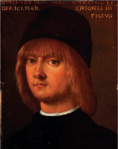Federico I. Gonzaga
Federico I. Gonzaga called il Gobbo (born June 25, 1441 in Mantua ; † July 14, 1484 ibid) was the son of Margrave Ludovico III. Gonzaga of Mantua and his successor as Margrave of Mantua from 1478.
biography
Origin and family
Federico was the eldest son of Margrave Ludovico III. Gonzaga von Mantua from his marriage to Barbara von Brandenburg . Like two of his sisters, he had a hereditary deformed spine . Despite this health problem, the parents succeeded, in contrast to the marriage arrangements for his sisters Susanna and Dorotea, which failed because of this, to organize a befitting marriage for Federico. The choice fell on Margarete von Bayern (1442–1479), a daughter of Albrecht III. , Duke of Bavaria-Munich . The initiation of marriage with a princess of German origin was certainly influenced by the will of the mother, who also arranged for Federico's sister Barbara Gonzaga to marry a German. The negotiations for the wedding were held in Mantua in 1462 and the engagement contract was signed on September 8 of the same year. Federico Gonzaga and Margarete von Bayern married on May 10, 1463 in Mantua.
Federico's military training was demanded and organized by his father, in line with family tradition. On the other hand, until the end of the 1960s he was obviously unable to play a politically active role. It was only from 1469 that his father was used not only for military but also for political purposes, as the contacts with the Sforza in Milan prove. It can be concluded from this that from this point onwards, Ludovico's decision to appoint him as his successor was made. In December 1476, after the assassination of Galeazzo Maria Sforza , Federico, together with his father, who was the capitano generale (commander) of the Sforza army, was mobilized and concentrated a contingent in Marcaria ready to intervene in the Milan area. Federico only played a subordinate role here. Despite his poor health and age 65, his father appeared in person on January 6, 1477 in Milan. Through his presence, he helped guarantee the succession of Gian Galeazzo Sforza under the reign of the Duchess Bona of Savoy .
Margrave of Mantua
The father died on June 12, 1478 and Federico was officially recognized as Margrave of Mantua on June 14. Right at the beginning of his reign, Federico faced a huge problem: the father's will had disappeared and he had four brothers who could make claims. Some sources report that the resolute mother, Barbara von Brandenburg, had a hand in it. There is an allegation that the will was intentionally destroyed. The fact is, the will disappeared without a trace. Margravine Barbara declared that she knew the contents of the document in which a division would have been established. To avoid disagreements between the children, she would proceed with this division. To what extent she controlled the history of the family and the state at this delicate moment has never been clarified.
This event repeated what happened when his father came to power: the land was divided. Only at that time Ludovico had the positive fact that his brothers died without heirs and the entire country fell back into his hands. The division that Federico undertook with his brothers was to shape the history of the Gonzaga State permanently and be final for the small country. The territories that he ceded to his brothers Gianfrancesco and Rodolfo were lost to Mantua forever. The main line died out with Vincenzo II Gonzaga in 1627 and this resulted in a war of succession that threatened Mantua's independence.
Federico had at least kept most of the Margraviate of Mantua, the brothers were given western and northern border areas. In the following weeks he was able to reach an agreement with his brothers on various territorial adaptations through which strategically important places such as Canneto and Viadana passed into his possession. A final agreement between all heirs was made in February 1479. On June 10, 1479, Emperor Friedrich III. the brothers the necessary investments . The division of the margravate was viewed with some skepticism among the allies; at the Milanese court of the Sforza, for example, the legitimate question was how Federico could keep the obligations of a politico-military alliance with Milan with the reduced resources.
At the beginning of 1479, Federico's contract with Milan was renewed, with an annual payment of 70,000 ducats. With 400 armed men and 500 infantrymen, he was to go to war for Milan, which was waged by Pope Sixtus IV and King Ferdinand of Naples against Lorenzo de 'Medici , ruler of the Republic of Florence . Federico's departure was postponed several times, however, and he did not leave until late April after receiving payment of the arrears and being appointed Governor General of all Milanese armed forces in the region. He moved to Tuscany via Pistoia and was then personally involved in the operations in the spring and summer of 1479, albeit with very mediocre results. The differences of opinion between the commanders general Ercole d'Este and the Gonzaga, and in particular a serious incident between the contingent of Mantua and des Este (over the booty of the castle of Casole d'Elsa , a fierce battle broke out, with numerous deaths - according to a chronicler over 100), had a negative impact on military operations and caused the Milanese government to relocate Federico and his men to the Perugia area of operations in July . In August a good part of the Mantua contingent deserted because they had not received any payment. However, Federico stayed in central Italy until October 12, 1479, when news of his wife's illness arrived and made him leave for Mantua; she died on October 14th.
Between June 1480 and January 1481 the marriage of his eldest daughter Chiara to Gilbert de Bourbon , the Count of Montpensier , was negotiated. The dowry was 26,000 ducats. This politically motivated wedding was celebrated with a big party and on June 16, 1481 Chiara traveled to France. Shortly thereafter, negotiations were held for the marriage of the eldest son Francesco (fifteen) and Isabella d'Este (seven), daughter of Duke Ercole and Eleonora of Aragón. An agreement was reached on the basis of a dowry of 25,000 ducats, plus an 8,000 share to be paid by Federico. When the contract was signed, the Marquis was represented by Francesco Secco. The engagement was honored in the following months with mutual visits and corresponding celebrations.
Pope Sixtus IV's urge to expand resulted in his alliance with the Republic of Venice in 1481, after the failed capture of Florence , in order to attack the Duchy of Ferrara . Since he also threatened Naples, the King of Naples also joined the alliance of the Ercole d'Este of Ferrara with Ludovico il Moro in Milan and the Medici in Florence . The war operations began in August 1482. Federico Gonzaga took on a subordinate role, since the army of the League was placed under the command of Federico da Montefeltro . The war also grazed the area of Mantua near Melara . In the previous months, Federico had his border castles repaired by the talented engineers Giovanni da Padova and Luca Fancelli as a precaution , including in Goito , Cavriana , Canneto , Viadana and Marcaria . Like his father, he had a great interest in architecture and, in addition to military objects, this also affected sacred buildings ; so he had the chapel di S. Maria dei Voti built in the cathedral of Mantua . In addition to the further expansion of Mantua, he was particularly interested in the castle in Marmirolo , built in 1435 by Margrave Gianfrancesco , which he had furnished in the style of his time. Federico's commitment to the development of the arts can be demonstrated through several letters in which he gave specific instructions. The artist Andrea Mantegna, who was already employed by his father, continued to work at the court of Mantua during the short period of his reign . In addition to painting and sculpture , Federico was also interested in goldsmithing , numismatics and typography .
Since August 1483 Federico could no longer take part personally in the military operations against Venice because of his poor health, although on April 12, 1483 he had been appointed capitano generale of the Duke of Milan and had signed a five-year contract. In the fighting taking place under the leadership of Alfonso, Duke of Calabria , also in the area of Mantua, he transferred his command to Francesco Secco. In October, after a brief siege, Asola , which is important for Mantua, was conquered. Federico allowed his young son Francesco to join the company under Francesco Secco to learn the weapons trade from him. Federico tried to consolidate control of the city of Asola, whose conquest would have been a modest but realistic goal of participating in the war, and had 400 inhabitants taken hostage to Mantua. Asola became Venetian again within the framework of the Peace of Bagnolo on August 7, 1484, a few weeks after Federico's death. As compensation, Mantua was awarded 60,000 ducats.
Federico I. Gonzaga died in Mantua on July 14, 1484. He had made his will several years before his death on April 21, 1479, shortly before his invasion of Tuscany. With the exception of the eldest son, none of the other children had his legacy of political significance. He asked to be buried “sine aliqua pompa aut cerimonia” (without pomp or ceremony) in the crypt of his ancestors in the Church of San Francesco, where his wife Margarete and his father Ludovico were also buried.
progeny

Federico married Margaret of Bavaria on May 10, 1463 in Mantua (January 1, 1442 - October 14, 1479), a daughter of Duke Albrecht III. from Bayern-Munich and had six children with her:
- Chiara (Clara) Gonzaga (July 1, 1464 - June 2, 1503) ⚭ February 25, 1481 Gilbert de Bourbon (1443 - October 15, 1496), Count of Montpensier
- Francesco II Gonzaga (1466–1519), Margrave of Mantua from 1484
- ⚭ February 12, 1490 Isabella d'Este (* May 18, 1474; † February 13, 1539), daughter of Ercoles I , Duke of Ferrara
- Sigismondo Gonzaga (1469 - October 3, 1525), cardinal since 1505
- Elisabetta Gonzaga (1471–1526) ⚭ February 11, 1489 Guidobaldo I da Montefeltro (* 1472; † 1508), Duke of Urbino
- Maddalena Gonzaga (* 1472 in Mantua; † January 8, 1490 in Pesaro) ⚭ October 27, 1489 Giovanni Sforza , Lord of Pesaro (* July 5, 1466; † July 27, 1510)
- Giovanni Gonzaga (* 1474; † 23 September 1525) ⚭ 1493 Laura Bentivoglio († 1523), daughter of Giovanni - Descendants: Margraves and Princes of Vescovado
Web links
Remarks
- ↑ According to a source from the 16th century, the will was burned: cfr.Archivio di Stato di Mantova, Fondo d'Arco, n.57: G. Daino, Series chronologica capitaneorum, marchionum ac ducum Mantue from anno 1368 ad annum 1550, c. 21r. Gian Maria Varanini: FEDERICO I Gonzaga, marchese di Mantova. In: Dizionario Biografico degli Italiani (DBI). Volume 45. Rome 1995. Retrieved July 3, 2018
Individual evidence
- ↑ a b c d e f g h Gian Maria Varanini: FEDERICO I Gonzaga, marchese di Mantova. In: Dizionario Biografico degli Italiani (DBI). Volume 45. Rome 1995. Retrieved July 3, 2018
- ^ Genealogical page on the family
- ↑ a b Family tree of the Sforza family. at genmarenostrum.com.
| predecessor | Office | successor |
|---|---|---|
| Ludovico III. |
Margrave of Mantua 1478–1484 |
Francesco II. |
| personal data | |
|---|---|
| SURNAME | Gonzaga, Federico I. |
| BRIEF DESCRIPTION | Margrave of Mantua |
| DATE OF BIRTH | June 25, 1441 |
| PLACE OF BIRTH | Mantua |
| DATE OF DEATH | July 14, 1484 |
| Place of death | Mantua |








